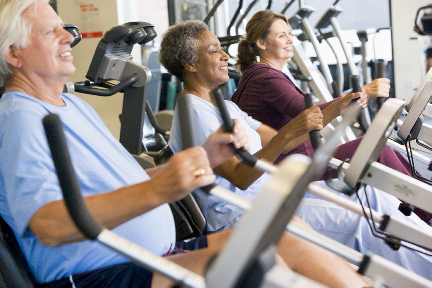This blog was written by Bethany Garrity. Meet our blogging fitness specialists at the NIFS website.
All too often, those of us working in corporate fitness find ourselves catering to the 15 percent of employees who would work out anyway—whether or not we, the stellar management staff, were onsite to assist and train them. That often leads me to ponder how we might creatively capture the attention of the other 85 percent.
Gimmicks and Creative Employee Health Promotions
I think the an swer to that question depends significantly on the demographic and the corporate culture in which we’re working. But by and large, it seems that gimmicks (sadly) go a long way, as does making fitness fun. Those who might dabble in offerings at their worksite fitness center (a.k.a. fence sitters) could be nudged into regular participation with a desirable prize (a.k.a. money) or if we fitness professionals (a.k.a. magicians) could convince them it was fun.
swer to that question depends significantly on the demographic and the corporate culture in which we’re working. But by and large, it seems that gimmicks (sadly) go a long way, as does making fitness fun. Those who might dabble in offerings at their worksite fitness center (a.k.a. fence sitters) could be nudged into regular participation with a desirable prize (a.k.a. money) or if we fitness professionals (a.k.a. magicians) could convince them it was fun.
I can say with confidence that NIFS staff member continue to generate unique, creative, and inviting opportunities for their audiences all over the country. Their enthusiasm for reaching that 85 percent never seems to wane. They are the experts!
Why Is It So Hard to Motivate Employees to Be Healthy?
I am left to wonder, though, what is it about human beings that makes changing behavior (particularly health behavior) so hard? We’re capable of being tricked into choosing better health, but we seldom do it without a nudge (intrinsic or extrinsic).
If you’re working to improve employee health (in a corporate fitness center, or from the human resources office), what works for your audience?

 ependence. Regular strength training can help them do this from a physical standpoint, but maintaining their cognitive abilities is equally important. Interestingly enough, a loss in cognitive abilities is a risk factor for falls.
ependence. Regular strength training can help them do this from a physical standpoint, but maintaining their cognitive abilities is equally important. Interestingly enough, a loss in cognitive abilities is a risk factor for falls. being physically active--up to 34.7 percent compared with 31.9 percent in 2008. This is also good news; moving more can’t be bad.
being physically active--up to 34.7 percent compared with 31.9 percent in 2008. This is also good news; moving more can’t be bad.  I know it can be difficult to target programs toward children, especially if you have age restrictions at your onsite fitness center. One of the things
I know it can be difficult to target programs toward children, especially if you have age restrictions at your onsite fitness center. One of the things  ow to play. Maybe our work-life balance is so poor that we work too hard, sleep too little, or sit too long to remember what it's like to have fun playing games. Or maybe we just need a little reminder.
ow to play. Maybe our work-life balance is so poor that we work too hard, sleep too little, or sit too long to remember what it's like to have fun playing games. Or maybe we just need a little reminder. s weight because although his past diet consisted of healthier foods, it was simply too much food for his body. However, he admits that he would not recommend this diet to anyone and is “not geared to say this is a good thing to do.”
s weight because although his past diet consisted of healthier foods, it was simply too much food for his body. However, he admits that he would not recommend this diet to anyone and is “not geared to say this is a good thing to do.” Sleep and exercise can be a vicious cycle. The more tired you are, the less motivation you have to exercise. Working in a corporate fitness program, I see a lot of tired and stressed people. The onsite fitness facility seems to help improve their moods.
Sleep and exercise can be a vicious cycle. The more tired you are, the less motivation you have to exercise. Working in a corporate fitness program, I see a lot of tired and stressed people. The onsite fitness facility seems to help improve their moods.